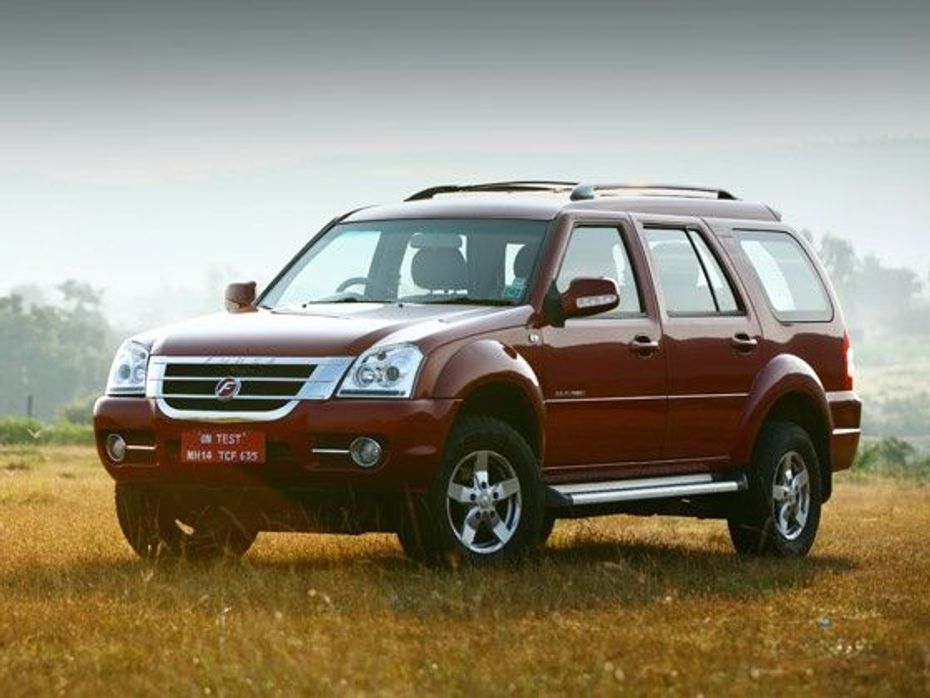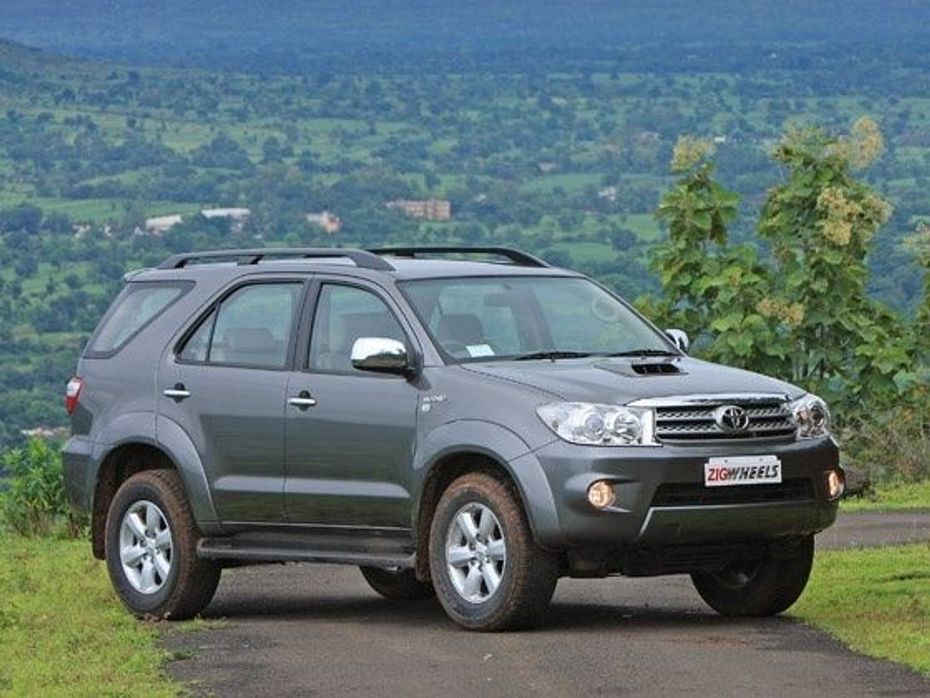 No More Diesel-iMT Powertrain In India, As Kia Discontinues It For The Sonet, Seltos And Carens
No More Diesel-iMT Powertrain In India, As Kia Discontinues It For The Sonet, Seltos And Carens
 Hyundai Creta Electric Reaches Dealerships, Check It Out In 9 Images!
Hyundai Creta Electric Reaches Dealerships, Check It Out In 9 Images!


Tata Safari
The Tata Safari has been with us for donkey’s years now, and has been the natural enemy of the Mahindra Scorpio for a long time as well. But it’s Mahindra’s killer pricing of the XUV500 that puts the top-end 4x4 Safari right in the firing line of the new XUV500 (Read : Special Coverage), with the price difference between them being only a few tens of thousands of rupees. That being said, the Safari has been getting a little long in the tooth now, and when pitted against the properly modern XUV500, it doesn’t really stand much of a chance. Both the cars have 2.2-litre common rail diesel engines which churn out almost identical power and torque figures, but being about 175kg heavier than the XUV makes the Safari a bit of a slouch in terms of performance.
Also missing in the Safari, is a modern permanent four-wheel drive system like the XUV’s, as it features an age-old 4x4 transfer case mechanism to split the torque between all four wheels when the driver slots the driver selector lever into 4x4 mode. In its current avatar, the Safari really isn’t a match for the XUV500, but Tata Motors is already testing a new version of this long-running favourite. And there’s a good chance that with all the technology developed for the Aria, this new Safari could really take the fight to the XUV500. But we’ll have to wait and watch out for that one.

Force One
This gigantic SUV from Force Motors was launched around the same time as Mahindra’s latest offering, and if you’re willing to cut Force Motors a little bit of slack considering that it’s the company’s first ever foray into making passenger vehicles, you’ll realize that the Force One is quite a capable machine. Unfortunately though, even though it offers typical large SUV styling, the lack of four-wheel drive pretty much restrict this machine to road use. The 2.2-litre diesel mill from the Force One makes almost the same power and torque figures as the XUV500 (Read : Special Coverage), the Mahindra is significantly quicker in a straight line. And while there is nothing wrong with the Force One in the way it drives, the XUV500 really manages to outclass it in terms of handling characteristics to a certain extent and in terms of the sheer number of features it offers to a large extent.
The top-end two wheel drive version of the XUV500, at Rs 11.88 lakh ex-showroom Delhi, costs about Rs 1.23 lakh more than Force One. However, this extra price is entirely justifiable thanks to the Mahindra packing in significantly more features and rather better styling, both outside and inside the vehicle. The bottom line is that you would only want to get yourself a Force One is if you want loads of space for all seven passengers in the car and a slightly more pliant ride.

Skoda Yeti
Now the Skoda Yeti might seem a strange contender to the likes of the XUV500 (Read : Special Coverage), but then again, Skoda does market it as an SUV. But the XUV500 and the Yeti have a rather important feature in common, which they do not share with the rest of the competition here, and that is a monocoque chassis. While the other “true” SUVs here have a more basic body-on-ladder-frame chassis arrangement, the Yeti and XUV500 use their body shell as the chassis structure, making them more like modern saloons in this regard. Being a Skoda, the Yeti is loaded up to the brim with toys and is the only one in this lot which can give the XUV500 a run for its money in terms of features. And while it matches the power and torque figures of the Mahindra, the 300kg lesser body weight means that on-road performance is much more spirited. On tarmac, handling is much tighter and car like, but when the going gets rough, even though the Yeti has a very capable permanent four-wheel drive system, the slightly lesser ground clearance and stiffer suspension setup means that the XUV500 really trumps it in this department.
The XUV500 is also larger, offering seating for seven people, as opposed to just five in the Yeti, but the smaller size does give the Yeti an advantage on crowded city roads. However, what really tips the scales in favour of the XUV500 is Mahindra’s spot-on price. At Rs 12.8 lakh ex-showroom Delhi for the top-end four-wheel drive version, this latest Mahindra is over Rs 4 lakh cheaper than the Skoda, making it much better value for money.

Toyota Fortuner
You might be wondering why we’re comparing a car which costs over Rs 20 lakh to a car that cost under Rs 13 lakh, but bear with us on this. While the Fortuner and XUV500 (Read : Special Coverage) may have a few critical technical differences between them, what they share is a common appeal. There isn’t a significant difference between both the cars’ sizes, and both have a very similar presence on the road – big, muscular SUVs commanding some real street-cred. Under the hood though, they’re rather different beasts. The larger 3.0-litre D-4D engine in the Fortuner produces 171PS of power and 343Nm of torque, making it significantly more powerful compared to the 2.2-litre mill in the XUV500.
But weighing in at 90kg more than the XUV, the Fortuner takes a bit of a hit in terms of outright performance, making the dash to 100km/h in 16 seconds, over 2 seconds slower than the XUV500. Both the Fortuner and the top-end model of the XUV500 feature full-time four-wheel drive systems, putting them pretty much at par off-the-road. Again, it is the over Rs 7 lakh price difference between the two which, when coupled with the fact that Mahindra has crammed its car with a zillion gadgets and toys, swings the value for money equation utterly in the direction of the XUV500. However, don’t discount the Fortuner so easily; that Toyota badge itself is worth its weight in gold, and the company has an untarnished reputation for reliability in the country.
 Mahindra XUV700
Mahindra XUV700
 Toyota Fortuner
Toyota Fortuner
India's largest automotive community
 No More Diesel-iMT Powertrain In India, As Kia Discontinues It For The Sonet, Seltos And Carens
No More Diesel-iMT Powertrain In India, As Kia Discontinues It For The Sonet, Seltos And Carens
 Hyundai Creta Electric: Things You Get With Each Of Its 5 Variants
Hyundai Creta Electric: Things You Get With Each Of Its 5 Variants
 Here Are Some Adrenaline Pumping Experiences From Auto Expo 2025 That You Should Not Miss!
Here Are Some Adrenaline Pumping Experiences From Auto Expo 2025 That You Should Not Miss!
 All You Need To Know About The Surprise Element At Auto Expo 2025: BMW iX1 LWB
All You Need To Know About The Surprise Element At Auto Expo 2025: BMW iX1 LWB
 Mahindra Scorpio N
Rs. 13.99 Lakh
Mahindra Scorpio N
Rs. 13.99 Lakh
 Mahindra Thar ROXX
Rs. 12.99 Lakh
Mahindra Thar ROXX
Rs. 12.99 Lakh
 Mahindra Bolero
Rs. 9.79 Lakh
Mahindra Bolero
Rs. 9.79 Lakh
 Mahindra XUV700
Rs. 13.99 Lakh
Mahindra XUV700
Rs. 13.99 Lakh
 Mahindra Scorpio
Rs. 13.61 Lakh
Mahindra Scorpio
Rs. 13.61 Lakh
 Hyundai Creta
Rs. 11.10 Lakh
Hyundai Creta
Rs. 11.10 Lakh
 Tata Punch
Rs. 5.99 Lakh
Tata Punch
Rs. 5.99 Lakh
 Mahindra Thar ROXX
Rs. 12.99 Lakh
Mahindra Thar ROXX
Rs. 12.99 Lakh
 Tata Nexon
Rs. 7.99 Lakh
Tata Nexon
Rs. 7.99 Lakh
 Mahindra XUV700
Rs. 13.99 Lakh
Mahindra XUV700
Rs. 13.99 Lakh